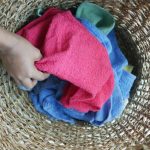When you consider the production of Waffle Terry, it's easy to overlook the environmental toll it takes. You've got significant water consumption, which strains local resources and contributes to scarcity. Then there's the chemical pollution, as dyes and finishing agents can contaminate water bodies and release harmful emissions. Plus, the energy-intensive manufacturing process adds to the carbon footprint, raising concerns about greenhouse gas emissions. With such intricate dynamics, it raises the question: are there sustainable alternatives that could mitigate these impacts?
Table of Contents
Water Consumption Concerns
Waffle Terry's production raises significant concerns about its water consumption, highlighting the urgent need for sustainable practices.
When you consider the entire process, from growing ingredients to producing the final product, you'll realize the vast amounts of water needed. Each stage, whether it's agriculture or manufacturing, contributes to a growing strain on local water sources.
In many regions, water scarcity is already a critical issue. If Waffle Terry continues its current practices without implementing changes, you might see adverse effects on communities and ecosystems. From depleting aquifers to affecting local wildlife, the repercussions can be severe. It's essential to acknowledge that these impacts aren't just statistical; they can alter the landscape and quality of life for many people.
You have the power to advocate for more sustainable methods in food production. Encourage Waffle Terry to adopt water-efficient technologies and to source ingredients from sustainable farms that prioritize water conservation. By supporting these changes, you can help reduce the overall water footprint of Waffle Terry. Remember, your choices can influence the industry and promote a long-term commitment to protecting vital water resources.
Chemical Usage and Pollution
The production of Waffle Terry involves various chemicals that can lead to pollution and pose risks to both human health and the environment. For example, dyes and finishing agents used in textile manufacturing can release harmful substances into water bodies, affecting aquatic life and potentially entering the food chain.
Additionally, the chemicals can emit volatile organic compounds (VOCs) into the air during production, contributing to air quality degradation. It's essential for you to understand these impacts and advocate for cleaner production methods in the industry.
Here's a quick overview of the types of chemicals involved and their effects:
| Chemical Type | Environmental Impact |
|---|---|
| Dyes | Water pollution, toxicity to aquatic life |
| Finishing agents | Soil contamination, bioaccumulation |
| Adhesives and coatings | VOC emissions, respiratory issues |
Energy Requirements in Production
Producing Waffle Terry requires significant energy inputs, particularly during the processes of heating, dyeing, and finishing the fabric. When you look at the overall production cycle, you'll find that energy consumption plays a critical role in determining the sustainability of this fabric.
The heating process alone demands a considerable amount of energy, as you'll need to heat the machinery and materials to specific temperatures to ensure proper fabric treatment.
During dyeing, the use of heated water is essential to achieve the desired colors while ensuring color uniformity. This adds another layer of energy demand to the production process.
After dyeing, the finishing process involves additional energy consumption, as you'll often utilize steam and heat to set colors and improve the fabric's aesthetic and functional qualities. If you opt for energy-intensive machines, the impact on energy usage increases substantially.
Carbon Footprint of Manufacturing
Understanding the energy inputs in Waffle Terry production sets the stage for examining its carbon footprint, which is a significant factor in assessing the environmental impact of manufacturing this fabric. The process begins with raw material extraction, often requiring fossil fuels, which contribute directly to greenhouse gas emissions.
When these materials are transported, you're adding even more emissions to the equation. During manufacturing, energy-intensive processes like weaving and dyeing exert additional pressure on the environment. If the factory relies on coal or natural gas, those emissions stack up, exacerbating climate change concerns.
Even with electric machinery, if the electricity comes from non-renewable sources, you're still facing a notable carbon footprint. Then there are the chemicals used in dyeing and finishing, which may not only emit carbon but can also lead to other harmful pollutants.
Sustainable Alternatives and Solutions
Exploring sustainable alternatives for Waffle Terry can significantly mitigate its environmental impact and reduce its carbon footprint. One effective solution is using organic cotton instead of conventional cotton, as it's grown without harmful pesticides and synthetic fertilizers. This not only promotes healthier ecosystems but also lowers the energy required during production.
You might also consider materials made from recycled fibers. By repurposing existing textiles, you can keep waste out of landfills and reduce the need for virgin resources. Innovations like hemp and bamboo fabrics can further enhance sustainability. These materials grow quickly, require fewer resources, and naturally replenish the soil.
Another option is to support brands focusing on ethical sourcing and environmentally friendly production processes. By choosing these companies, you encourage a shift in the industry towards more sustainable practices.
Lastly, consider buying less and caring for your Waffle Terry products properly. Regular maintenance and timely repairs can extend their lifespan, reducing the need for frequent replacements. By making conscious choices, you can contribute to a more sustainable future while still enjoying the comfort of Waffle Terry.
Frequently Asked Questions
What Materials Are Typically Used in Waffle Terry Production?
In waffle terry production, you'll typically find cotton or cotton blends, polyester, and sometimes bamboo. These materials provide softness, durability, and moisture-wicking properties, making waffle terry a popular choice for towels and clothing.
How Does Waffle Terry Compare to Other Fabrics?
When comparing waffle terry to other fabrics, you'll find it's softer and more absorbent. It's great for towels and clothing, but it might not be as durable as some synthetic alternatives. Choose according to your needs!
Are There Certifications for Sustainable Waffle Terry Products?
Yes, you can find several certifications for sustainable waffle terry products. Look for labels like Global Organic Textile Standard (GOTS) or OEKO-TEX, which indicate environmentally friendly practices in production and responsible sourcing of materials.
What Is the Lifespan of Waffle Terry Items?
Waffle terry items typically last several years with proper care. You should wash them gently and avoid harsh detergents. If you take care of them, you'll enjoy their comfort and durability for a long time.
How Can Consumers Recycle Waffle Terry Fabrics?
You can recycle waffle terry fabrics by checking local textile recycling programs, repurposing them into cleaning cloths, or donating old items to charities. Always verify if the facility accepts this material for effective recycling.
- How Does Ring Spun Cotton Affect Garment Fit and Shape Retention? - August 13, 2024
- What Are the Challenges in Producing Ring Spun Cotton? - August 13, 2024
- Is Ring Spun Cotton Suitable for Plus-Size Clothing? - August 13, 2024







